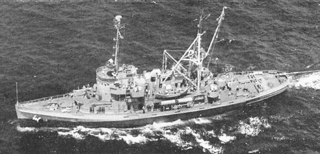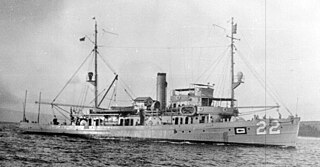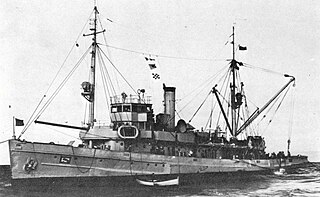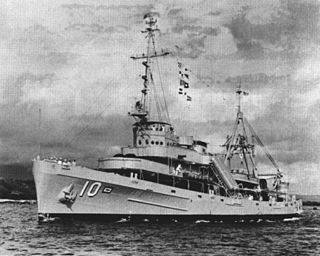
The Republic of Korea Navy, also known as the ROK Navy or South Korean navy, is the naval warfare service branch of the South Korean armed forces, responsible for naval and amphibious operations. The ROK Navy includes the Republic of Korea Marine Corps, which functions as a branch of the Navy. The ROK Navy has about 70,000 regular personnel including 29,000 Republic of Korea Marines. There are about 160 commissioned ships with the ROK Navy. The naval aviation force consists of about 70 fixed-wing and rotary-wing aircraft. The ROK Marine Corps has about 300 tracked vehicles including assault amphibious vehicles.

The third USS Penguin (ASR–12) was a submarine rescue ship in the United States Navy during World War II. She was the lead ship of a class of three vessels all originally laid down as fleet ocean tugs before being converted to rescue ships before completion.

The Type 925 Dajiang (大江) is a type of naval auxiliary ship belonging to the People's Republic of China. Each ship is usually equipped with up to two Type 7103 DSRV class Deep Submergence Rescue Vehicles (DSRVs). The lead ship of the Dajiang class is the Changxingdao. The Type 925 is a submarine tender that can also be used as a submarine rescue ship, and hence, it is designated as a submarine support ship by Chinese.

The third USS Falcon, (AM-28/ASR-2) was a Lapwing-class minesweeper in the United States Navy. She later became a submarine rescue ship.

USS Widgeon (AM-22/ASR-1) was an Lapwing-class minesweeper acquired by the United States Navy for the dangerous task of removing mines from minefields laid in the water to prevent ships from passing. Later converted to a submarine rescue ship. Widgeon was named by the Navy after the widgeon, a freshwater duck.
The first USS Chewink (AM-39/ASR-3) was a Lapwing-class minesweeper in the United States Navy. She was later converted to a submarine rescue ship.

The first USS Ortolan(AM-45/ASR-5) was a Lapwing-class minesweeper in the United States Navy. She was later converted to a submarine rescue ship. She was named after the ortolan, a European bunting.

The first USS Mallard (AM-44/ASR-4) was a Lapwing-class minesweeper in the United States Navy. She was later converted to a submarine rescue ship.

The USS Coucal (ASR-8) was a Chanticleer-class submarine rescue ship in the United States Navy.

USS Greenlet (ASR-10) was a Chanticleer-class submarine rescue ship in the United States Navy. Constructed during World War II, the vessel was launched in 1942 and commissioned in 1943. Greenlet initially served at the United States Navy base at Pearl Harbor, Territory of Hawaii and Midway Atoll before transferring to Guam. During the period spent at Midway and Guam she aided in the training of submarine crews that would take part in the blockade of Imperial Japan. After the war ended, Greenlet transferred to Japan and escorted captured Japanese submarines back to the United States in 1946, spending the next couple of years training submarine crews. During the Korean War, Greenlet re-positioned back to Japan before returning to American waters. In 1958 and 1965, Greenlet took part in salvage operations of United States Navy vessels in Pacific waters. In early 1970, the vessel took part in deep recovery operations of a Grumman C-2 Greyhound aircraft that had crashed off Vietnam, earning the ship a Meritorious Unit Award. In June 1970, the ship was decommissioned, transferred to the Turkish Navy and renamed TCG Akin. Akin remained in service with the Turkish Navy until 17 November 2017
The Republic of Korea Navy was founded on November 11, 1945 as Marine Defense Group after Korea was liberated from the Empire of Japan. The ROK Navy is the oldest service within the ROK Armed Forces. In 2015, the South Korean navy celebrated its 70th anniversary.

A submarine rescue ship serves as a surface support ship for submarine rescue and deep-sea salvage operations. Methods employed are the McCann Rescue Chamber, Deep Submergence Rescue Vehicles (DSRV's) and deep sea diving operations.

The Republic of Korea Navy Special Warfare Flotilla is a special operations force of the Republic of Korea Navy. The WARFLOT is also known as ROKN UDT/SEAL, because the UDT/SEAL is the most publicly known branch of the flotilla.

The Cheonghaejin-class ASR is a submarine rescue ship class of the Republic of Korea Navy. Only one ship has been built in her class, ROKS Cheonghaejin, in 1995. Its operations include rescuing trapped sailors in submarines, naval operation support for submarines, underwater research and mapping support, and recovery of sunk vessels. It is equipped with a deep submergence rescue vehicle (DSRV) that operates up to 500 metres (1,600 ft), and a rescue chamber that holds up to nine people.

ROKS Cheonan (PCC-772) was a Pohang-class corvette of the Republic of Korea Navy (ROKN), commissioned in 1989. On 26 March 2010, she broke in two and sank near the sea border with North Korea, killing 46 sailors. An investigation conducted by an international team of experts from South Korea, United States, United Kingdom, Canada, Australia, and Sweden concluded that Cheonan was sunk by a torpedo launched by a North Korean Yeono-class miniature submarine.
ROKS Daegu (FFG-818) is the lead ship of the Daegu-class frigate in the Republic of Korea Navy. She is named after the city, Daegu.

Yangyang-class minesweeper is a ship class of minesweepers currently in service on the Republic of Korea Navy.

ROKS Tongyeong (ATS-31) is the lead ship of the Tongyeong-class salvage and rescue ship in the Republic of Korea Navy. She is named after the city, Tongyeong.

ROKS Gwangyang (ATS-32) is the second ship of the Tongyeong-class salvage and rescue ship in the Republic of Korea Navy. She is named after the city, Gwangyang.



















